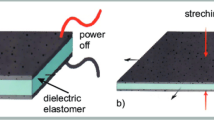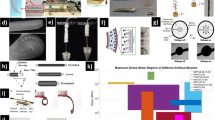Abstract
In this chapter, we explain how behaviour-based approaches can be used to control soft robots. Soft robotics is a strongly growing field generating innovative concepts and novel systems. The term “soft” can refer to the basic structure, the actuators, or the sensors of these systems. The soft aspect results in a number of challenges that can only be solved with new modelling, control, and analysis methods whose novelty matches those of the hardware. We will present prior achievements in the area of behaviour-based systems and suggest their application in soft robots with the aim to increase the fault tolerance while improving the reaction to unexpected disturbances.
Access this chapter
Tax calculation will be finalised at checkout
Purchases are for personal use only
Preview
Unable to display preview. Download preview PDF.
Similar content being viewed by others
References
Albu-Schaeffer A, Eiberger O, Grebenstein M, Haddadin S, Ott C, Wimboeck T, Wolf S, Hirzinger G (2008) Soft robotics. IEEE Robotics and Automation Magazine 15(3): 20–30
Arkin R (1998) Behaviour-Based Robotics. MIT Press, ISBN-10: 0-262-01165-4; ISBN-13: 978-0-262-01165-5
Armbrust C, Braun T, Föhst T, Proetzsch M, Renner A, Schäfer B H, Berns K (2010) RAVON – the robust autonomous vehicle for off-road navigation. In: Baudoin Y, Habib M K (ed) Using robots in hazardous environments: Landmine detection, de-mining and other applications, Woodhead Publishing Limited, ISBN: 1 84569 786 3; ISBN-13: 978 1 84569 786 0
Armbrust C, Kiekbusch L, Berns K (2011) Using behaviour activity sequences for mo-tion generation and situation recognition. In: Proceedings of the International Conference on Informatics in Control, Automation and Robotics (ICINCO). Noordwijkerhout, The Netherlands, pp 120–127
Armbrust C, Kiekbusch L, Ropertz T, Berns K (2012) Verification of behaviour networks using finite-state automata. In: Glimm B, Krüger A (ed) KI 2012: Advances in Artificial Intelligence. Springer, Saarbrücken, Germany
Armbrust C, Kiekbusch L, Ropertz T, Berns K (2013) Quantitative aspects of behaviour network verification. In: Zaiane O, Zilles S (ed) Proceedings of the 26th Canadian Con-ference on Artificial Intelligence. Lecture Notes in Computer Science, vol 7884. Spring-er, Regina. Saskatchewan, Canada
Armbrust C, Kiekbusch L, Ropertz T, Berns K (2013) Tool-assisted verification of be-haviour networks. In: Proceedings of the 2013 IEEE International Conference on Robot-ics and Automation (ICRA 2013). Karlsruhe, Germany
Armbrust C, Proetzsch M, Schäfer B H, Berns K (2010) A behaviour-based integration of fully autonomous, semi-autonomous and tele-operated control modes for an off-road ro-bot. In: Proceedings of the 2nd IFAC Symposium on Telematics Applications. IFAC, Politehnica University, Timisoara, Romania
Armbrust C, Schmidt D, Berns K (2012) Generating behaviour networks from finite-state machines. In: Proceedings of the German Conference on Robotics (Robotik)
Barrett C, Stump A, Tinelli C (2010) The satisfiability modulo theories library (smt-lib). www.SMT-LIB.org. Accessed 16 Sep 2014
Behrmann G, David A, Larsen K G (2006) A tutorial on uppaal 4.0
Brooks R (1986) A robust layered control system for a mobile robot. IEEE Journal of Robotics and Automation (RA) 2(1):14–23
Clarke E M, Emerson E A (1982) Design and synthesis of synchronization skeletons us-ing branching time temporal logic. In: Kozen D (ed) Logics of Programs - Workshop. Lecture Notes in Computer Science (LNCS), vol 13. Springer, Berlin, Heidelberg, pp 52–71
Deimel R, Brock O (2013) A compliant hand based on a novel pneumatic actuator. In: Proceedings of the IEEE International Conference on Robotics and Automation 2013 (ICRA 2013). pp 2039–2045
Floyd R W (1967) Assigning meanings to programs. In: Schwartz J T (ed) Mathematical Aspects of Computer Science. Proceedings of Symposia in Applied Mathematics, vol 19. American Mathematical Society, Providence, Rhode Island, USA, pp 19–32
Hoare C A R (1969) An axiomatic basis for computer programming. Communications of the ACM 12(10):576–583
Kiekbusch L, Armbrust C, Berns K (2014) Formal verification of behaviour networks in-cluding hardware failures. In: Proceedings of the 13th International Conference on Intel-ligent Autonomous Systems (IAS-13). Padova, Italy
Luksch T (2010) Human-like Control of Dynamically Walking Bipedal Robots. Disserta-tion, University of Kaiserslautern, Verlag Dr. Hut, ISBN: 978-3-86853-607–2
Marchese A D, Onal C D, Rus D (2014) Autonomous soft robotic fish capable of escape maneuvers using fluidic elastomer actuators. Soft Robotics 1(1):75–87
Matarić M J, Michaud F (2008) Behaviour-based systems. In: Siciliano B, Khatib O (ed) Springer Handbook of Robotics. Springer Berlin Heidelberg, pp. 891–910
Park Y L, Chen B R, Wood R J (2011) Soft artificial skin with multi-modal sensing ca-pability using embedded liquid conductors. In: Proceedings of the IEEE Sensors 2011 Conference. Limerick, Ireland, pp 81–84
Proetzsch M (2010) Development Process for Complex Behavior-Based Robot Control Systems. Dissertation, University of Kaiserslautern, Verlag Dr. Hut, ISBN: 978-3-86853-626–3
Queille J P, Sifakis J (1982) Specification and verification of concurrent systems in CESAR. In: Dezani-Ciancaglini M, Montanari U (ed) International Symposium on Pro-gramming - Proceedings of the 5th Colloquium. Lecture Notes in Computer Science (LNCS), vol 137. Springer-Verlag, London, UK, pp 337–351
Ropertz T, Berns K (2014) Verification of behavior-based networks - using satisfiability modulo theories. In: Proceedings for the joint conference of ISR 2014 and ROBOTIK 2014. VDE VERLAG GMBH, pp 669–674
Wilhelm L, Proetzsch M, Berns K (2009) Oscillation analysis in behavior-based robot ar-chitectures. In: Dillmann R, Beyerer J, Stiller C, Zöllner J, Gindele T (ed) Autonome Mobile Systeme. Informatik aktuell, Springer, pp 121–128
Author information
Authors and Affiliations
Editor information
Editors and Affiliations
Rights and permissions
Copyright information
© 2015 Springer-Verlag Berlin Heidelberg
About this paper
Cite this paper
Armbrust, C., Kiekbusch, L., Ropertz, T., Berns, K. (2015). Soft Robot Control with a Behaviour-Based Architecture. In: Verl, A., Albu-Schäffer, A., Brock, O., Raatz, A. (eds) Soft Robotics. Springer, Berlin, Heidelberg. https://doi.org/10.1007/978-3-662-44506-8_8
Download citation
DOI: https://doi.org/10.1007/978-3-662-44506-8_8
Published:
Publisher Name: Springer, Berlin, Heidelberg
Print ISBN: 978-3-662-44505-1
Online ISBN: 978-3-662-44506-8
eBook Packages: EngineeringEngineering (R0)




